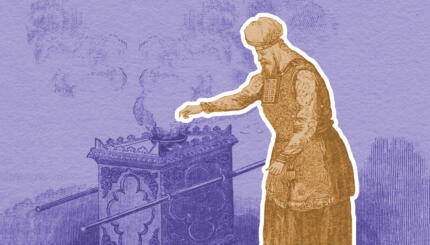Commentary on Parashat Vayakhel, Exodus 35:1-38:20; Numbers 19:1-22
In this week’s portion, Vayakhel, Moses assembles the entire Israelite community and tells them what God has commanded. He instructs the people to “take gifts” to God to help create the sacred Mishkan — the Tabernacle. (Exodus 35:4-9) As a result, “Men and women, all whose hearts moved them, all who would make an elevation offering of gold to Adonai, came bringing brooches, earrings, rings, and pendants — gold objects of all kinds.” (Exodus 35:22)
The Torah in this instance states that the motivation for the Israelites’ actions came from their hearts. Visualizing the many people who, “moved by their hearts,” brought their valuables to support the greater needs of the community evokes a striking image. It makes us wonder how were they able to respond so quickly and collectively. What made their hearts quicken?
Harming the Heart
Our tradition states: “Do not stand too long, for standing too long is harmful to the heart.” (Babylonian Talmud, Tractate Baba Batra 16b) A heart that is not used, one that is not active and thus becomes insensitive to the needs and pressures of the outside community, deteriorates and can no longer contribute to the health of the entire body.
What, on the other hand, does having a heart that is moved — or, as various translations indicate, having a heart that is “lifted” or a “willing heart” — mean? Our tradition teaches us about many different aspects of the heart: We read of Pharaoh’s heart that was “hardened” toward the Jewish people. We sing the lyrics “So long as still within the innermost heart a Jewish spirit sings… our hope is not lost” in Hatikvah [the national anthem of the State of Israel]. During tefillah (prayer) we pray to love God with all of our heart and with all of our soul.

Help us keep Jewish knowledge accessible to millions of people around the world.
Your donation to My Jewish Learning fuels endless journeys of Jewish discovery. With your help, My Jewish Learning can continue to provide nonstop opportunities for learning, connection and growth.
It is a Yiddish saying, however, that I believe encapsulates the meaning of the heartfelt actions described in Parshat Vayakhel: Di klainer hartz nemt arum di groisseh velt, “The heart is small and embraces the whole wide world.”
The heart is indeed small — just the size of a fist — but it helps us cope with the many challenges that we face in our communities. Like this hand tucked inside each of us, the heart has the power to strike like a fist or to gather and embrace like an open hand. It is up to each of us to learn how to move our heart to embrace the world.
Questions for Discussion
What does a Jewish heart need in order to be moved? Is it Jewish study, practice, a combination of both, or any other choices?
The text states: “Everyone who excelled in ability and everyone whose spirit moved him” (Exodus 35:21) responded to Moses’ command. Characterize both groups. In what way do they differ? Is one group better than the other?
What can we do to involve those people whose hearts are not moved to respond to the needs of the Jewish community? How can we “resuscitate” these people?
Provided by the Union for Reform Judaism, the central body of Reform Judaism in North America.



